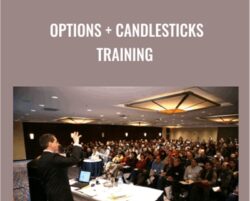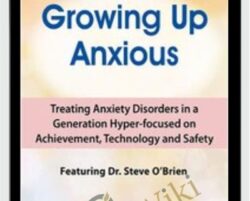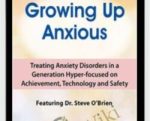We all want kids to be successful, safe, and secure, but such good intentions are having unintended consequences.Three societal ingredients…. a hyper-academic mindset, preoccupation with safety, and a tech-obsessed society… are fueling childhood anxiety, leaving kids fearful, avoidant, and ill-equipped for adulthood.Watch child psychologist Steve O’Brien, Psy.D., for 2 days filled with practical strategies as he presents a three-level treatment model for childhood anxiety using targeted, evidenced-based therapies to:Connect with and “rewire” anxious children and familiesProvide child-friendly instruction about anxiety and the brainPromote self-expression and healthy coping in shut-down kidsReduce debilitating social anxiety in adolescentsTreat technology-related worries, obsessions, and compulsionsDevelop anxiety-free safety plans for distressed kids and parentsDon’t miss out on this cutting-edge program for equipping and empowering kids to not only cope with anxiety, but to thrive as they develop a growing sense of both competence and confidence! Summarize the psychosocial characteristics of the “internet generation” and their contribution to anxiety development in children and adolescents.Describe the primary developmental, systemic, academic, and social-technological factors relevant to the development and maintenance of anxiety disorders in children and families.Identify the various social, emotional, and behavioral manifestations of anxiety in children in multiple contexts, including home and school.Utilize semi-structured observational and interview methods for collecting relevant history and clinical information with anxious and minimally verbal children and their parents/caretakers.Determine effective rapport-building strategies with anxious, resistant, and defensive children and parents/caretakers.Adopt a ‘parent consultation’ model as a supplement to individual child and family therapy and as part of an integrated treatment approach.Conduct ‘Child-Focused Family Therapy’ using therapeutic agendas and directive communication techniques.Teach children a developmentally appropriate psychoeducation framework for understanding the relationship between anxiety, the brain, and the body.Implement self-regulation strategies to reduce child/adolescent anxiety and promote adaptive coping.Identify clinical, co-occurring diagnostic patterns with respect to anxiety and related disorders in children and how to determine initial treatment targets.Distinguish between over-arching versus disorder-specific interventions for child/adolescent anxiety. As well as the 3 levels of anxiety treatment.Implement and integrate developmentally-appropriate CBT, desensitization, and exposure therapy techniques to enhance treatment with anxious children.Get 2-Day Growing Up Anxious: Treating Anxiety Disorders in a Generation Hyper-focused on Achievement, Technology & Safety – Steve O’Brien, Only Price $175GROWING UP ANXIOUS – 3 KEY INGREDIENTSEARLY EMPHASIS ON HIGH ACHIEVEMENT AND PERFORMANCEEmotional costs of a hyper-academic mindset and over-evaluationPerformance philosophy pitfalls: perfectionism and procrastinationConsequences of strong individualism: anti-collaborative attitudesTECHNOLOGY IMMERSION: PLUGGED IN BUT TUNED OUTTech-savvy, socially naiveFearless online, fearful offlineGratification-dependent, grit-deficientPREOCCUPATION WITH SAFETY AND POTENTIAL THREATOverprotected but underdeveloped….socially and emotionallyHow dysregulated adults promote anxiety-ridden kidsFailure to launch: Why “adulting” is difficult and frighteningINTEGRATING EVIDENCED-BASED TREATMENT APPROACHESBehavior therapy/modificationCognitive-behavior therapyFamily-focused/systemic therapyInterpersonal therapyPlay/art/creative therapiesMindfulness-based therapiesGUIDELINES FOR RAPPORT-BUILDING AND CLINICAL INTERVIEWINGSemi-structured parent interviews: Combining engagement with efficiencyDevelopmentally-sensitive child interviews: Integrating observation, play and dialogueParent consultation: Constructing a framework for parental involvementPSYCHOEDUCATION FOR PARENTS AND KIDS: THE FIRST INTERVENTIONTeaching parents about their child’s overactive brainGiving a child-friendly “tour of the brain”Highlighting the mind-body connectionSocial Anxiety DisorderEvaluating cognitive versus physiological featuresCognitive-behavioral methods for getting teens out of their heads and into the worldRole-playing and free association games for promoting real-time interactionDesensitization strategies for combating social avoidanceBIOPSYCHOSOCIAL TREATMENT: THE SECOND INTERVENTION“LOWERING THE TEMPERATURE, SLOWING THE PACE”Reducing Emotional Intensity and Conflict for a Calmer EnvironmentHealthy habits and daily transition ritualsSelf-expression and support-seeking skills3 R’s of anxiety management: Recognize, Relax, RedirectTARGETED TREATMENT FOR MAJOR (DSM-5™) ANXIETY DISORDERS: THE THIRD INTERVENTIONGeneralized Anxiety DisorderIdentifying manifestations of chronic worryCognitive strategies for discrediting the “what-if? person”Self-talk for empowering the “helpful coach”Cognitive-behavioral redirection for worriesParadoxical relaxation for overachieversSeparation Anxiety DisorderAssessing psychological and somatic componentsPre-treatment preparation: It’s all about the planDeveloping a treatment-support teamAction plans for high-distress episodesStrategies for distressed/enmeshed parentsPhobias and Panic DisorderCognitive and physical/physiological symptomsEssential ingredients for desensitization“Challenge ladders” for gradual exposurePlanning-for-panic strategiesObsessive-Compulsive DisorderVariations in obsessive-compulsive symptomatology“Brain challenges” for rigid perfectionistsMindfulness strategies: “Balloon breathing and wet noodles” for high-threat perceiversControlled withdrawal and replacement for tech-addictsCO-OCCURRING DISORDERS: TREATMENT IMPLICATIONS, RISKS, AND LIMITATIONSDepressive DisordersAttention-Deficit/Hyperactivity DisorderAutism Spectrum DisordersANXIETY-RIDDEN AT SCHOOL: CONSIDERATIONS AND CLASSROOM APPLICATIONSRelationship-building with distressed/disruptive kidsDealing with the (dreaded) 3 D’s:Defiance, Disrespect, DisruptionCreating a calm, responsive classroomReducing task avoidance and test anxietyManaging compulsive technology usageIdentifying, intervening, and preventing bullyingTips for (post) pandemic adjustmentMEASURING TREATMENT PROGRESSEvaluating symptomatology and functional levelSchool consultation and recommendationsMedication: Guidelines for discussion and referralGet 2-Day Growing Up Anxious: Treating Anxiety Disorders in a Generation Hyper-focused on Achievement, Technology & Safety – Steve O’Brien, Only Price $175Tag: 2-Day Growing Up Anxious: Treating Anxiety Disorders in a Generation Hyper-focused on Achievement, Technology & Safety – Steve O’Brien Review. 2-Day Growing Up Anxious: Treating Anxiety Disorders in a Generation Hyper-focused on Achievement, Technology & Safety – Steve O’Brien download. 2-Day Growing Up Anxious: Treating Anxiety Disorders in a Generation Hyper-focused on Achievement, Technology & Safety – Steve O’Brien discount.
 Options + Candlesticks Training – Steve Nison
₹13,778.00
Options + Candlesticks Training – Steve Nison
₹13,778.00
 Deep Abundance Integration – Steve Pavlina
₹5,478.00
Deep Abundance Integration – Steve Pavlina
₹5,478.00
2-Day Growing Up Anxious: Treating Anxiety Disorders in a Generation Hyper-focused on Achievement, Technology & Safety – Steve O’Brien
₹28,386.00



